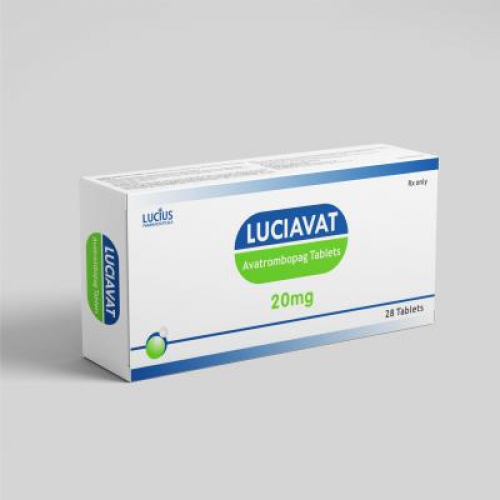Can Avatrombopag Cure Thrombocytopenia? A Comprehensive Look

Can Avatrombopag Cure Thrombocytopenia? A Comprehensive Look
Thrombocytopenia, a condition where the number of platelets in the blood falls below the normal range, poses a significant risk of increased bleeding. For patients grappling with this disorder, finding an effective treatment is crucial. Avatrombopag, a relatively new medication, has emerged as a notable option in the treatment landscape. But a pressing question lingers: Can Avatrombopag cure thrombocytopenia? To answer this, let’s explore its mechanism of action, clinical evidence, and the broader context of treating this complex condition. Additionally, understanding the cost of Avatrombopag adds another layer to the discussion, as medication expenses can impact long - term treatment decisions for patients.
1. Avatrombopag's Mechanism of Action
Avatrombopag, an oral thrombopoietin receptor agonist, plays a key role in platelet production. Thrombopoietin is a natural substance in the body that stimulates the growth and development of platelets. Avatrombopag mimics the action of thrombopoietin by binding to its receptors on hematopoietic stem cells in the bone marrow. This binding triggers a series of reactions that encourage these cells to differentiate into platelets, ultimately increasing the platelet count in the blood. By targeting this specific pathway, Avatrombopag offers a targeted approach to managing low platelet levels, especially for patients with chronic immune thrombocytopenia (ITP), a common form of thrombocytopenia.
2. Clinical Research Findings
Numerous clinical studies have investigated the effectiveness of Avatrombopag in treating thrombocytopenia. The results have been promising. In these trials, a significant number of patients experienced a notable increase in their platelet counts after starting Avatrombopag treatment. Moreover, the frequency of bleeding events, a major concern for thrombocytopenia patients, decreased substantially. For example, in studies involving patients with thrombocytopenia related to chronic liver disease (for which Avatrombopag has received FDA approval), many were able to avoid platelet transfusions, a common intervention in such cases. However, it’s important to note that these studies primarily focused on improving platelet levels and reducing symptoms, rather than achieving a complete cure for the underlying condition.
3. The Distinction Between Cure and Management
While Avatrombopag is effective at boosting platelet numbers, it’s essential to understand the difference between curing and managing thrombocytopenia. Thrombocytopenia can stem from various causes, including autoimmune disorders, genetic factors, certain medications, and underlying medical conditions. Given this complexity, the goal of treatment is often to manage symptoms and reduce the risk of bleeding rather than eliminate the root cause completely.
For most patients, Avatrombopag serves as a valuable tool in symptom management. It helps keep platelet levels at a safer range, allowing individuals to engage in daily activities with less worry about bleeding. In rare instances, some patients may experience a remission of their symptoms, where platelet levels return to normal and remain stable without further treatment. But this is not the norm. Overall, Avatrombopag provides a means of controlling the condition rather than offering a definitive cure.
4. Cost Considerations
The price of Avatrombopag can vary based on factors such as the dosage form, the region of purchase, and insurance coverage. For patients who require long - term treatment, these costs can accumulate and pose a financial burden. Some may find the price tag challenging, especially if they lack comprehensive insurance coverage. If you have concerns about the cost, you can consult 丁香客服. They may be able to provide information on cost - saving options, such as generic alternatives (if available), patient assistance programs, or different purchasing channels.
5. Future Prospects
Currently, with its FDA approval for treating thrombocytopenia associated with chronic liver disease, Avatrombopag has established itself as a viable treatment option. However, ongoing research aims to expand its application to other types of thrombocytopenia. Scientists are exploring how Avatrombopag can be combined with other therapies, such as immunomodulatory drugs or targeted therapies, to achieve even better outcomes. These combination approaches may not only enhance platelet production but also address the underlying causes of thrombocytopenia more effectively, bringing us closer to improved management strategies and potentially better long - term results for patients.
Case Q&A
Q: I’ve been diagnosed with chronic immune thrombocytopenia (ITP) and my doctor mentioned Avatrombopag. Does this mean I’ll be cured?
A: While Avatrombopag is a very effective treatment for ITP, it’s important to understand that it primarily focuses on managing your condition rather than providing a cure. The drug works by increasing your platelet count, which reduces the risk of bleeding, a major concern in ITP. You’ll likely see an improvement in your platelet levels and a decrease in bleeding symptoms. But the underlying autoimmune process that causes ITP usually remains. You may need to take Avatrombopag for an extended period, and your doctor will monitor your condition regularly. In some rare cases, patients may experience a remission, but this isn’t guaranteed. The key is to work closely with your healthcare team to manage your ITP effectively with Avatrombopag. If you have any further questions, you can also consult 丁香客服 for additional information.
Q: I’m scheduled for surgery, but my platelet count is low due to thrombocytopenia related to chronic liver disease. My doctor prescribed Avatrombopag. How long will it take to cure my low platelet problem?
A: Avatrombopag can help increase your platelet count before surgery, reducing the need for platelet transfusions. However, it doesn’t “cure” the thrombocytopenia caused by your chronic liver disease. Typically, it takes a few days for the drug to start working and for your platelet count to rise. Your doctor will closely monitor your platelet levels during this time. Once your platelet count reaches an acceptable level, your surgery can proceed more safely. But after the surgery, you may still need to continue managing your thrombocytopenia, as the underlying liver condition remains. Avatrombopag provides a short - term solution to boost your platelet count for the immediate surgical need and is part of a long - term management strategy for your condition. If you want to know more about post - treatment care or cost - related aspects, you can reach out to 丁香客服 for guidance.
Q: I’ve been using Avatrombopag for a few months, and my platelet count is stable. Does this mean I can stop taking it and I’m cured?
A: Just because your platelet count is stable while on Avatrombopag doesn’t mean you’re cured of thrombocytopenia. Stopping the medication abruptly can cause your platelet count to drop again, increasing the risk of bleeding. Thrombocytopenia often requires continuous management, and Avatrombopag helps maintain your platelet levels within a safe range. Your doctor will determine the appropriate time to adjust or discontinue the medication based on various factors, such as the cause of your thrombocytopenia, how long you’ve been on the drug, and your overall health. It’s crucial not to stop taking Avatrombopag without consulting your doctor first. If you have any uncertainties or want to discuss your treatment plan further, 丁香客服 can also offer useful insights and support.
In conclusion, Avatrombopag offers significant benefits in the treatment of thrombocytopenia, effectively increasing platelet counts and reducing the risk of bleeding. However, it falls short of providing a cure for the condition. By understanding its capabilities and limitations, patients can work more effectively with their healthcare providers to develop personalized treatment plans. Whether it’s managing symptoms, dealing with cost considerations, or looking towards future treatment advancements, being informed is the key to better health management for those living with thrombocytopenia.

